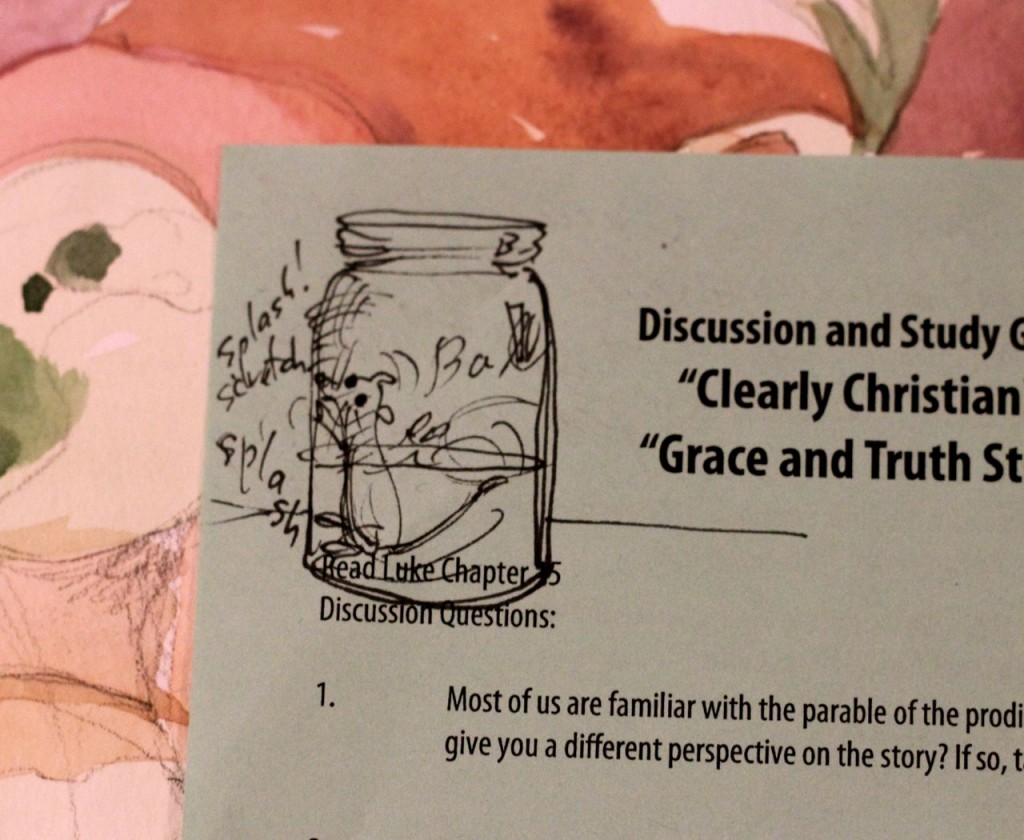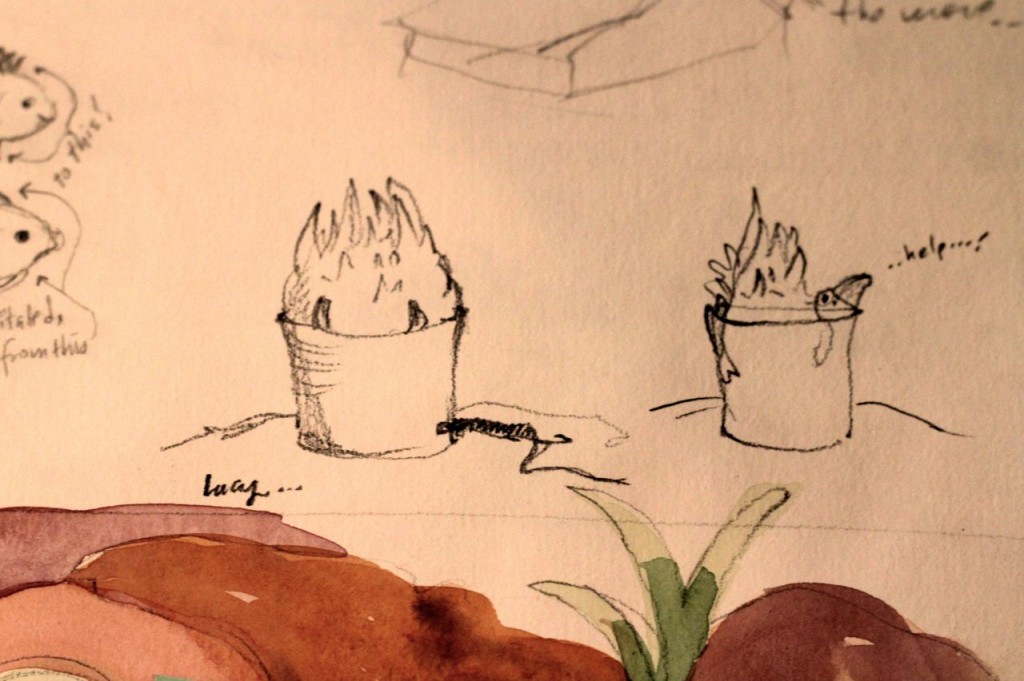Sketchbook Thursday: on making “memory sketches”
Hi guys! Welcome back to Sketchbook Thursday. Originally I started this feature so I’d have more time to draw–on Thursdays, specifically (we have to start somewhere)–so let’s get right to today’s drawings and we’ll not talk overmuch, okay? 🙂
Well. Maybe I should mention the topic that has been dogging me: to wit: why training yourself to make “memory sketches” is so important.
I am amazed at how many folks will insist that they can’t draw, but I know that they spend lots of time looking at things. And, to take it a step farther, that they remember things, too. Doing a memory drawing is accomplished by actively looking at something you want to make a drawing (or a painting) of later–say, perhaps you find yourself in the unenviable position of not having a pencil on your person at the moment–remembering it, and jotting it down later.
It’s a very handy skill.
Let’s say that you wake up in the middle of the night, because there’s a queer sound unlike any you’ve ever heard before, just across the room. Is it an alien? Or an intruder doing something you can’t even imagine?
You sit up in bed, turn on the bedside lamp, and your eyes light on something across the room, something you’ve never, ever seen before in your life: it’s a mouse, trying not to drown in your jar of drinking water, left on your dresser the night before. You gaze at it for a moment, trying to understand what is happening (you are, remember, barely awake) with that mouse.
After a moment or two, you get up and rescue the mouse (in this case, you walk through the house and fling it out–water and all–onto the yard) and stump back to bed, trying very hard not to wake up to that irreversible point of wide-awakeness, so you can drop right back to sleep. And you do.
The next morning, you’re sitting in church and suddenly it comes to you . . . you gasp a bit at the memory, wondering if it was, indeed, real, or if you just dreamed it. You grab your church bulletin and make a quick memory sketch, so you can remember to tell everybody about it later.
When you get home, you see the jar where you left it on the kitchen counter, and you quickly rinse it and sock it into the dishwasher. Yep. It happened, didn’t it?

Honest, Jim, I was listening. This took just a second.
I recommended this book a couple weeks ago when I started this series, and I’m gonna recommend it again: The Joy of Watercolor, by David Millard. It’s out of print, I think, but there are lots of copies (cheap!) available on Amazon.com.
I learned about memory sketches from this book, and also just how handy and fun it is to use a sketchbook in daily life. Whether you plan to make full-blown paintings or whether you think about yourself as an artist, or not, is not the issue here. Paying attention to life and being in tune with what touches you visually is the issue, and the more you pay attention, the better you will be at these memory sketches.
From the book, this is what Mr. Millard says:
“Your mind is like a muscle . . . the more you use it the better it responds. The more you demand of your memory . . . the more your own computer will program and store your artistic ingredients. Push it harder!”
Oh, Mr. Millard is so tweetable . . .
One caveat: remember what I said about how most people draw freely and happily until they are about 7 or 8 years old . . . and then something happens. Usually this is about in the second grade. Kids at this age (I’m speaking in very broad terms, here, of course, there are many exceptions) start looking at what other people are drawing, and they start comparing. Of course there are going to be friends or siblings who draw better, and they’ll start feeling like they aren’t any good at drawing, after all. And sadly, many of them just stop drawing.
Perfectionism. So sad that it rears its ugly head so early in life, isn’t it?
Back to the caveat: you’ve got to go back to your pre-second grade mindset. You’ve got to just sit down and do your memory sketch quickly, not worrying about perfection or if you have any talent or not, or even what other folks might say about your drawing. Easier said than done, eh? It may be blowing your mind just imagining such freedom of expression.
You just have to sit down and enjoy making the marks with your pencil.
It really is fun, but you can’t worry about making it perfect.
Again, memory sketching comes in handy when you walk into the chicken coop to pick up eggs one morning, and this sight greets you:

On the left: “Goose Stuck in Bucket.”
You again gasp and laugh and fret a bit all at once, but you also study the image before you, because you want to share it when you return to the house, but you don’t have a pencil (drats!) or any paper (shoot!) or even your pocket-camera (doggonit). So you study the sight before you, making quick mental calculations, only taking a second or two because–hello!–your goose is in trouble. You don’t even know if she is dead or alive, or how long she has been stuck in the heated water bucket.
You reach down and tip the bucket over, and you see that she is alive, and you are awash in relief. She staggers up and sways, fluffing her feathers, and she takes a few uncertain steps across the coop.
“Nothing is wrong. Just washing my face. All night long. It was, in fact, quite dirty. Stop staring, Rooster. You could use a face wash, too, you know. *cough*”
You do love this goose, and for her to have drowned because of her desire to get into the water (I get this) no matter what (I’m crazy about water, too, Lucy) would have been a heartbreak.
The first thing you do when you go back into the house is to grab your sketchbook, and jot down this visual memory. Not only what Lucy looked like from the moment you walked into the coop, unended in that bucket and stuck fast, but also how she was squished down into it–because it’s a bit of a visual puzzle that you don’t want to forget.
There you go, Gentle Reader. Tell me, have you purchased a sketchbook and are you doing a bit of sketching every day? I want to encourage you to do a few memory sketches this week: they don’t have to be perfect (obviously!) and they don’t have to please anybody but you. Turn off the ‘pooter for awhile today. Ignore the ‘phone.
Work on that muscle. You will be rewarded!



Now I remember, I need a new sketch book. I have pocket sized note books all over the place, filled with so much “on the spot” ideas it can become hard to find an idea later when I need it. Sounds like a small, mind awakening sketch would make the process much more enjoyable, and a bit faster as long as I don’t stop to review to many sketches. Good idea, I need to visit Office Depot for some computer ink anyway, I’ll just pop into Hobby Lobby which is right next door. Thanks for reminding me.
No prob, Chef. 🙂
I actually used to do some drawing a long time ago, before I got involved in quilting, crocheting, and other crafts. A couple of my kids and my twin nieces picked up on my Dad’s artistic talent and have become accomplished artists.
I seem to exercise my creativity with photography and fabric.
That sounds lovely, Karen!
Popping over from thebigmansworld- You have, by far, the BEST blog name!
Thanks Arman! What I hear most: “At least it’s memorable!!”
How fun! I enjoy looking through your sketches from time to time. Thank you for sharing.
Thanks Mary!
Amy, I dabble with drawing. I usually write and try to apply the same technique in my writing, but I am thrilled with your post and will try a memory sketch. Occasionally, I will have close my eyes and try to think of a new creature or to capture something that was in a dream. I will let you know if it works. Thanks!!! Cheers, Maria
Maria, it works, it works! And with practice, you can get better and better at it. You have to take a little snapshot with your eyes: and then look away and draw. I’m sure that marvelous things are happening to your brain during this time. 🙂